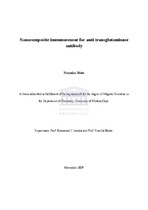| dc.contributor.advisor | Iwuoha, Emmanuel | |
| dc.contributor.advisor | Baker, Priscilla | |
| dc.contributor.author | West, Natasha | |
| dc.contributor.other | Dept. of Chemistry | |
| dc.contributor.other | Faculty of Science | |
| dc.date.accessioned | 2013-12-11T07:26:53Z | |
| dc.date.available | 2011/02/22 07:55 | |
| dc.date.available | 2011/02/22 | |
| dc.date.available | 2013-12-11T07:26:53Z | |
| dc.date.issued | 2009 | |
| dc.identifier.uri | http://hdl.handle.net/11394/2531 | |
| dc.description | Magister Scientiae - MSc | en_US |
| dc.description.abstract | Coeliac disease (CD) is a gluten intolerance condition that results in the flattening of the villi, which line the bowel. It is the most common cause of malabsorption of food nutrients. This inability to absorb sufficient levels of nutrients causes many of the common symptoms experienced by CD patients. Some of the symptoms, which lead to an increase in mortality rate, include chronic diarrhea, fatigue, iron-deficient anemia and osteoporosis. People with
CD have higher than normal levels of certain antibodies in their blood. Thus, the concentration of anti-transglutaminase antibody (anti-tTG) in human sera is an important analytical marker for the diagnosis of CD. An immunosensor is a type of biosensor that has an antigen or antibody fragment as its biological recognition component. The specificity of the molecular recognition of antigens by antibodies to form a stable complex is the basis of immunosensor technology. In this work, overoxidized polypyrrole (OvoxPpy) was
electrosynthesized as a noval sensor platform on a glassy carbon electrode (GCE). The OvoxPpy was then doped with gold-nanoparticles (GNP) by electrodeposition using cyclic voltammetry to form GNP|OvoxPpy||GCE electrode system. Morphology and size of the GNP|OvoxPpy||GCE nanocomposite were determined using scanning electron microscopy.
The electrochemical immunosensor for anti-tTG antibodies was prepared by immobilizing transglutaminase antigen (tTG-antigen) onto the GNP|OvoxPpy||GCE by drop coating and allowed to incubate for 2 hrs. The electrochemical characterization of the nanocomposite platform and immunosensor were studied by voltammetry and electrochemical impedance
spectroscopy (EIS). Charge transfer resistance, Rct (obtained from EIS data fitting) of [Fe (CN)6]3-/4- redox probe was used as the analytical parameter for measuring the interfacial kinetics which occurred as a result of the bio-recognition event (affinitive binding) between the tTG-antigen and anti-tTG antibody. Rct was found to increase with increased concentration of the antibody as a result of the reluctance to the flow of redox probe charge across the interface. Antibody concentration as low as in 1:4000 dilutions was detected. | en_US |
| dc.language.iso | en | en_US |
| dc.publisher | University of the Western Cape | en_US |
| dc.subject | Biosensor | en_US |
| dc.subject | Immunosensor | en_US |
| dc.subject | Polypyrrole | en_US |
| dc.subject | Gold nanoparticles | en_US |
| dc.subject | Cyclic voltammetry | en_US |
| dc.subject | Square wave voltammetry | en_US |
| dc.subject | Electrochemical impedance spectroscopy | en_US |
| dc.subject | Coeliac disease | en_US |
| dc.subject | Transglutaminase (tTG) antigen | en_US |
| dc.subject | Anti-transglutaminase antibodies | en_US |
| dc.title | Nanocomposite immunosensor for anti-transglutaminase antibody | en_US |
| dc.type | Thesis | en_US |
| dc.rights.holder | University of the Western Cape | en_US |
| dc.description.country | South Africa | |

